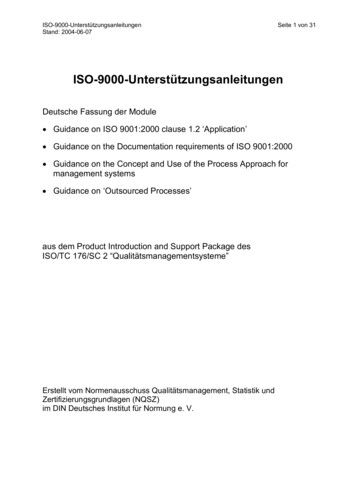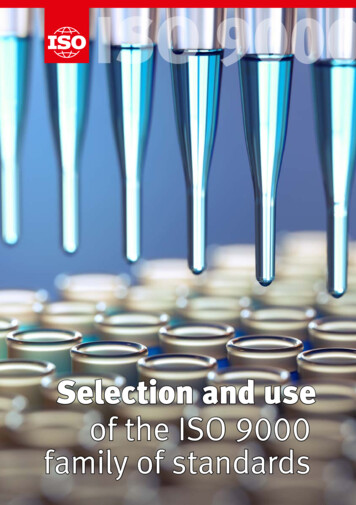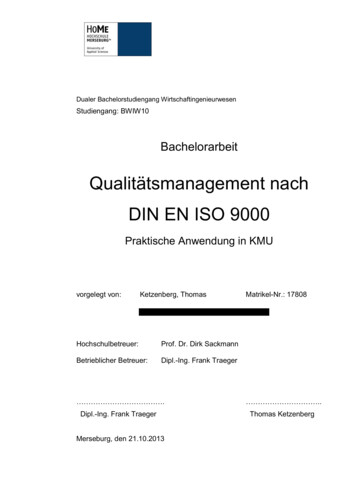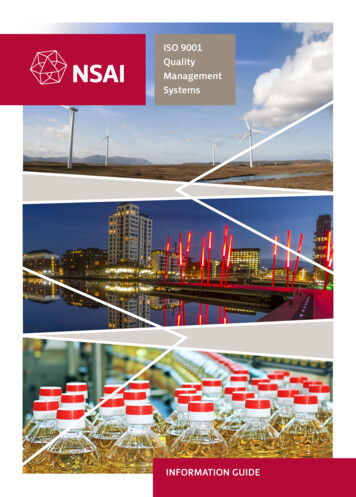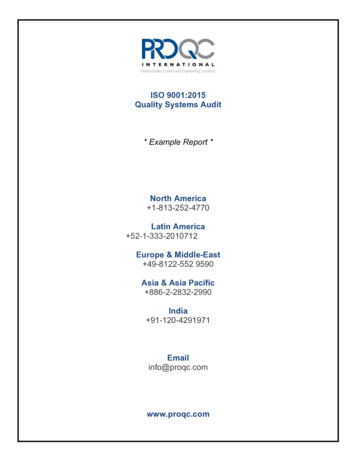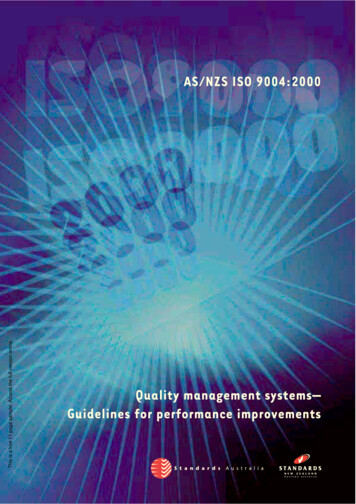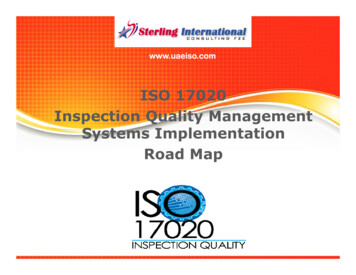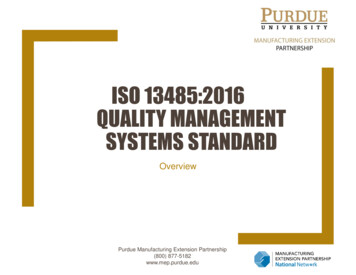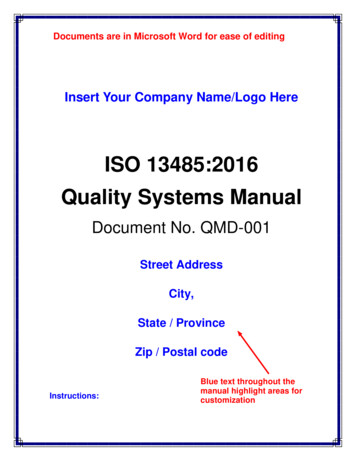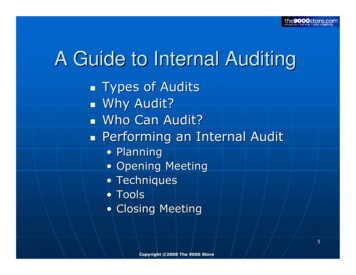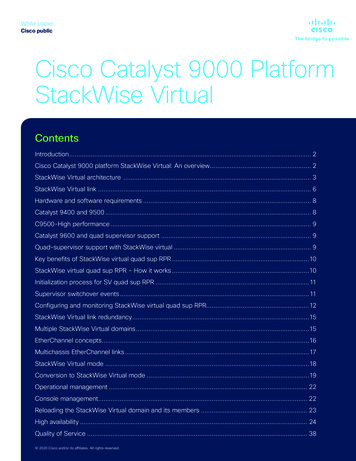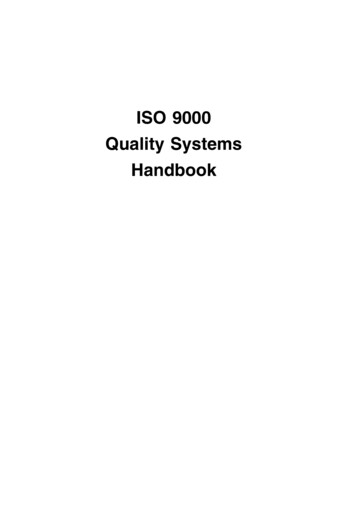
Transcription
ISO 9000Quality SystemsHandbook
ISO 9000Quality SystemsHandbookFourth EditionCompletely revised in response to ISO 9000:2000David HoyleOXFORDAUCKLANDBOSTONJOHANNESBURGMELBOURNENEW DELHI
Butterworth-HeinemannLinacre House, Jordan Hill, Oxford OX2 8DP225 Wildwood Avenue, Woburn, MA 01801-2041A division of Reed Educational and Professional Publishing LtdA member of the Reed Elsevier plc groupFirst published 1994Second edition 1994Third edition 1998Reprinted 1999Fourth edition 2001 David Hoyle 2001All rights reserved. No part of this publication may be reproduced inany material form (including photocopying or storing in any medium byelectronic means and whether or not transiently or incidentally to someother use of this publication) without the written permission of thecopyright holder except in accordance with the provisions of the Copyright,Designs and Patents Act 1988 or under the terms of a licence issued by theCopyright Licensing Agency Ltd, 90 Tottenham Court Road, London,England W1P 0LP. Applications for the copyright holder’s writtenpermission to reproduce any part of this publication should be addressedto the publishersBritish Library Cataloguing in Publication DataA catalogue record for this book is available from the British LibraryLibrary of Congress Cataloguing in Publication DataA catalogue record for this book is available from the Library of CongressISBN 0 7506 4451 6For information on all Butterworth-Heinemann publications visit our website atwww.bh.comComposition by Genesis Typesetting, Laser Quay, Rochester, KentPrinted and bound in Great Britain
ContentsixPrefaceChapter 1IntroductionChapter 2Basic conceptsPrinciples or prescriptionQualityThe interested partiesThe characteristics of qualityAchieving sustaining and improving qualitySummaryBasic concepts – Food for thoughtChapter 3Role, origins and application of ISO 9000The role of ISO 9000Origin of ISO 9000Changes to ISO 9000ExclusionsAn alternative structureCertification to ISO 9001:2000SummaryRole, origins and application – Food for thought1181819222532767780808391102106111113114
vi ContentsChapter 4Quality management systemSummary of requirementsEstablishing a quality management systemIdentifying processes (4.1a)Sequence and interaction of processes (4.1b)Criteria and methods for effective operation andcontrol (4.1c)Documenting a quality management system (4.1, 4.2.1)Documented procedures (4.2.1c)Documents that ensure effective planning, operationand control of processes (4.2.1d)Implementing a quality management system (4.1)Managing processes (4.1)Ensuring information availability (4.1d)Ensuring the availability of resources (4.1d)Measuring, monitoring and analysing processes (4.1e)Maintaining a quality management system (4.1)Continual improvement in the QMS and itsprocesses (4.1 and 4.1f)Preparing the quality manual (4.2.2)Control of documents (4.2.3)Control of records (4.2.1e and 4.2.4)SummaryQuality Management System QuestionnaireQuality Management System – Food for 70172174180207217218219Chapter 5Management responsibilitySummary of requirementsManagement commitment (5.1)Customer focus (5.2)Quality policy (5.3)Quality objectives (5.4.1)Quality management system planning (5.4.2)Responsibility and authority (5.5.1)Management Representative (5.5.2)Internal communication (5.5.3)Management Review (5.6)SummaryManagement Responsibility QuestionnaireManagement Responsibility – Food for hapter 6Resource managementSummary of requirementsDetermining resources (6.2.1)302302304
ContentsviiProviding resources (6.2.1)Competence of personnel (6.2.1)Training, awareness and competence (6.2.2)Infrastructure (6.3)Work environment (6.4)SummaryResource Management QuestionnaireResource Management – Food for thought307310314329336349350351Chapter 7Product realizationSummary of requirementsPlanning product realization processes (7.1)Customer-related processes (7.2)Design and development (7.3)Purchasing (7.4)Production and service provision (7.5)Control of measuring and monitoring devices (7.6)SummaryProduct Realization QuestionnaireProduct Realization – Food for Thought353353356376401449473510534535540Chapter 8Measurement, analysis and improvementSummary of requirementsMonitoring, measurement, analysis and improvementprocesses (8.1)Customer satisfaction (8.2.1)Internal audit (8.2.2)Monitoring and measurement of processes (8.2.3)Monitoring and measurement of product (8.2.4)Control of nonconforming product (8.3)Analysis of data (8.4)Improvement (8.5)SummaryMeasurement, analysis and improvement questionnaireMeasurement, analysis and improvement – food ppendix AGlossary647Appendix BRelated web sites658Index661
Preface and acknowledgementsSince the third edition of this handbook was published in 1998 there has beena radical change to the ISO 9000 family of standards. The standards havechanged in structure from 20 elements to 8 sections; they have changed inintent from quality assurance to customer satisfaction; the terminology haschanged so as to suit all types of organizations and there has been a change indirection from a focus on planning, inspection and test and the removal ofnonconformity to a focus on objectives, processes, measurement, analysis andimprovement.This meant that the handbook that had evolved over the previous eight yearsrequired a complete rewrite. However, I have maintained the basic purpose ofthe handbook – that of providing the reader with an understanding of eachrequirement of ISO 9001 through explanation, examples, lists, tables anddiagrams. As there were over 300 requirements in the 1994 version of ISO 9001,this led to a book of considerable size – it was not intended as a quick read! Itwas and remains a source of reference and although I was tempted torestructure the book as an A-Z of ISO 9000 to reduce duplication, I haveadhered to following the structure of the standard, adding clause numbers tothe headings to make it user-friendly. The handbook is therefore laid out so asto follow the section numbers of ISO 9001.Most of the requirements of the 1994 version are included in the 2000 versionof ISO 9001, but few remain exactly the same. Many have been reworded orcondensed to remove over-prescriptive requirements and focus on generalconcepts. The differences between the 1994 and 2000 versions are shown in text
x Preface and acknowledgementsboxes by the side of the new requirement. In revising this handbook a lot ofdetail had to be omitted primarily as it was focused on manufacturingexamples or detail requirements that are no longer included in the standard.Previous versions of this handbook therefore remain relevant and a usefulsource of information for those interested in seeking such detail.In the previous editions the approach taken was to identify a requirement andthen explain its meaning followed by some examples to illustrate how it could beimplemented. In this new edition I have followed a more structured approachand for each requirement answered three basic questions: What does it mean? Whyis it important? How is it implemented? This is so that the requirements may beperceived as reflecting concepts valid outside the context of ISO 9000.At the end of each chapter there is a Questionnaire built from therequirements of the standard. It is not intended that these questions be used byauditors but by users of the standard in order to test the completeness of thesystem they have formalized. In place of the lists of do’s and don’ts and thetask list of previous editions, I have included a section on Food for Thought. Thisis intended to cause the reader to reflect on the previous chapter, perhaps evenchange perceptions but mostly confirm understanding. The do’s and don’tsand task lists are within the text and will be consolidated in a new edition ofthe ISO 9000 Pocket Guide.Throughout the book a common approach has been taken to the requirements of ISO 9000. This approach is a development of that what was used inthe previous editions. The standard has become more generic, it now presentsthe requirements in a more user-friendly format and has adopted the processapproach to management. While the requirements of ISO 9001 are expressed ina way that takes the reader through a cycle starting with the quality policy,leading onto quality objectives and ending with performance being reviewedagainst objectives, there remain many inconsistencies that could lead toconfusion. Many of the linkages between policy, objectives, processes andresults are inferred – they are not expressed unambiguously. It is only bystudying ISO 9000, ISO 9001 and ISO 9004 and searching for understandingthat a clear logic emerges. The use of the word quality creates an anomaly andtends to represent the standard as simply a tool to meet customer qualityrequirements and no others. This is not to say that the standard is flawed. It isonly saying that the concepts could be presented more clearly. Consequently Ihave taken an approach that requires the principles and requirementscontained in the ISO 9000 family to be perceived as general business conceptsand not simply limited to the achievement of quality in its narrowest sense.While the arguments for taking this approach are addressed in the book, thetheme of the book is reflected in the following principles.The quality policy exists to shape behaviour and establish the core values inan organization and therefore equates with the corporate policy – no benefitsare gained from specifically expressing a quality policy and ignoring other
Preface and acknowledgementsxipolicies because all policies influence the behaviours that are key to satisfyingthe needs of interested parties.Quality is a strategic objective that is established to fulfil the needs andexpectations of all interested parties and therefore equates with the corporateobjectives – no benefits are gained from ranking quality equally with otherobjectives.The quality management system is the management system that enables theorganization to fulfil its purpose and mission. Consequently in this handbookthe term management system is used throughout (except when referring to therequirements of the standard) rather than terms quality system, qualitymanagement system or simply QMS. Organizations have only one system – nobenefits are gained from formalizing part of a system that focuses on quality.By dropping the word quality from this term, it is hoped that the reader willbegin to perceive a system that is significantly more beneficial than the qualitysystem addressed by ISO 9000:1994.The adequacy, suitability and effectiveness of the management system is judgedby how well the system enables the organization to achieve its objectives,operate efficiently and fulfil its purpose and mission – no benefits are gainedfrom simply focusing on one aspect of performance when it is a combinationof factors that deliver organizational performance.If you read the handbook from cover to cover you will discover that theseprinciples are repeated regularly throughout in one form or another Hopefullythis is not too irritating but the handbook is intended as a reference book andI felt that the alternative of frequent cross references would be just as irritating.However, we rarely learn by a chance observation and it often requiresfrequent exposure to ideas presented in different forms and context before ourbeliefs or perceptions are changed.The first three chapters provide background information with the subsequent five chapters dealing with the sections of ISO 9001 that contain therequirements. In this way the chapter numbers of the book mirror the sectionheadings of the ISO 9001.Chapter 1 addresses the issues that have arisen in the use of ISO 9000, thevarious perceptions surrounding the standard and the associated infrastructure as well as some of the negative influences and misconceptions. Thissets the scene for the approach taken in the remainder of the book.Chapter 2 is a revised and much enhanced chapter on basic concepts. Theopportunity has been taken to place the more general concepts and principlesin this chapter and provide greater alignment with the topics covered by thestandard. Following the style of the first edition, I have included managementtheory drawn from authors in the field of both general management andquality management.Chapter 3 addresses the role of the family of standards and answersfrequently asked questions about its purpose, uses, application and origin.
xii Preface and acknowledgementsHaving discovered the misconceptions surrounding the use of the standard Iwas prompted to explore a little more of the history, not of the standard itselfbut of the concepts that are expressed in the standard and applied to its use.Many criticize the standard for the burden of bureaucracy that has arisen sinceits introduction but what I have found is that ISO 9000 is not a cause but asymptom of an age in which prescription and regulation has dominatedbusiness relationships for centuries.Chapters 4 – 8 address the requirements of ISO 9001. As the 1987 and 1994versions of ISO 9001 were structured around twenty elements, the chapterswere not exceedingly long. As there are now only five sections of requirementsin ISO 9001 covering some 250 requirements with most of the original 20elements being crammed into Section 7 on Product Realization, Chapter 7 of thehandbook is unfortunately very long. However, the clause numbers added tothe headings together with a comprehensive index should make finding topicsrelatively easy.Finally an appendix contains a glossary of terms used in ISO 9000 and in thishandbook. Definitions contained in ISO 9000 have not been repeated except forthe purpose of comparison.Other than for comparisons between the 1994 and the 2000 version of thestandard, all references to ISO 9000, ISO 9001 and ISO 9004 refer to the 2000versions. In view of the differing perceptions, when the term ISO 9000 is usedin this book it means the standard and not its attendant infrastructure.Comment on any aspect of the infrastructure will be referred to it by its usualname – auditing, consulting, certification, training or accreditation.I have retained the direct style of writing referring to the reader as ‘you’. Youmay be a manager, an auditor, a consultant, an instructor, a member of staff, astudent or simply an interested reader. You may not have the power to do whatis recommended in this book but may know of someone who does whom youcan influence.The interpretations are those of the author and should not be deemed to bethose of the International Organization for Standardization, any NationalStandards Body or any Certification Body.As a result of the radical changes reflected in ISO 9000:2000 many thousandsof organizations that committed to ISO 9000 certification now face a dilemma.In order to keep their certificates they may have to make some significantchanges to the way their organization is managed and will therefore need todecide whether to maintain certification or to abandon it. ISO 9000 merelybrings together concepts that have been applied in organizations for manyyears – not some unique concepts of management that only exist to put a‘badge on the wall’. By all means reconsider the value of ISO 9000 certificationbut it would be foolish to abandon concepts that have been proven to sustainand improve an organization’s performance in the belief that they areinextricably linked with certification. The fact that some ISO 9000 certified
Preface and acknowledgementsxiiiorganizations perform worse than non-certified organizations is no morereason to denounce the concepts embodied in ISO 9000 than to denounceNewtonian Physics formulated in the 17th century because several road andrail bridges collapsed in the 20th century. This book is written for those whowant to improve the performance of their organization and whether or notcertification is a goal, I hope the book will continue to provide a source ofinspiration in the years ahead.I am grateful to my associate John Thompson whose ideas and insightprovided the clarity needed to explain the requirements of ISO 9000 in thewider context of business management and for his teachings on processmanagement, to my wife Angela for her constructive comment and editing ofthe manuscript and to Claire Harvey of Butterworth-Heinemann for hercontinual encouragement and patience as one deadline after another passed by.I am indebted to the many clients and associates I have talked with particularlyin the months upto and shortly after the publication of ISO 900:2000. Theteachings of P. F. Drucker have been a constant inspiration particularly inclarifying issues on strategic management. The teachings of W. E. Deming havebeen particularly useful for this fourth edition in clarifying the theory ofvariation and confirming my ideas on systems theory. The teachings of J. M.Juran have also been a constant inspiration particularly concerning breakthrough and control principles and quality planning. The treatment ofcompetence in Chapter 6 would not have been possible without the teachings ofShirley Fletcher and contributions from John Thompson.David ril 2001
Chapter 1IntroductionBy three methods we may learn wisdom:First, by reflection, which is noblest;Second, by imitation, which is easiest; andthird by experience, which is the bitterest.ConfuciusPerceptionsSince the publication of the ISO 9000 family of standards in 1987 a newindustry has grown in its shadow. The industry is characterized by StandardsBodies, Accreditation Bodies, Certification Bodies, Consulting Practices,Training Providers, Software Providers and a whole raft of publications,magazines, web sites and schemes – all in the name of quality! But has ISO 9000fulfilled its promise? There are those with vested interests that would arguethat it has improved the efficiency and effectiveness of organizations. Equallyothers would argue that it has done tremendous damage to industry. One ofthe problems in assessing the validity of the pros and cons of the debate is thevery term ISO 9000 because it means different things to different people.Perceptions that have been confirmed time and again by consultants, otherorganizations and frequent audits from the certification bodies over the last 20years makes these perceptions extremely difficult to change. If ISO 9000 isperceived rightly or wrongly, as a badge on the wall or a set of documents, thenthat is what it is. If this was not the intent of ISO 9000 then clearly we have todo something about it. But why should these perceptions be changed? After all,can 340,000 organizations have got it wrong? Some organizations in fact diduse ISO 9000 wisely but they are likely to be in the minority. Manyorganizations also chose not to pursue ISO 9000 certification and focused on
2 ISO 9000 Quality Systems HandbookTQM but that too led to dissatisfaction with the results. As an introduction tothis handbook on ISO 9000:2000 it may be useful to take a look at theseperceptions – look at how we have come to think about ISO 9000, quality,quality systems, certification and inspection. A realization of these perceptionswill hopefully enable us to approach the new standard with a differentperspective or at least provide food for thought.How we think about ISO 9000To the advocate, ISO 9000 is a standard and all the negative comments havenothing to do with the standard but the way it has been interpreted byorganizations, consultants and auditors. To the critics, ISO 9000 is what it isperceived to be and this tends to be the standard and its support infrastructure.This makes any discussion on the subject difficult and inevitably leads todisagreement.Some people often think about ISO 9000 as a system. As a group ofdocuments, ISO 9000 is a set of interrelated ideas, principles and rules andcould therefore be considered a system in the same way that we refer to themetric system or the imperial system of measurement. ISO 9000 is both aninternational standard and until December 2000, was a family of some 20international standards. As a standard, ISO 9000 was divided into 4 parts withpart 1 providing guidelines on the selection and use of the other standards inthe family. The family of standards included requirements for qualityassurance and guidelines on quality management. Some might argue that noneof these are in fact standards in the sense of being quantifiable. The criticsargue that the standards are too open to interpretation to be standards –anything that produces such a wide variation is surely an incapable processwith one of its primary causes being a series of objectives that are notmeasurable. However, if we take a broader view of standards, any set of rules,rituals, requirements, quantities, targets or behaviours that have been agreedby a group of people could be deemed to be a standard. Therefore by thisdefinition, ISO 9000 is a standard.ISO 9000 is also perceived as a label given to the family of standards and theassociated certification scheme. However, certification was never a requirement of any of the standards in the ISO 9000 family – this came fromcustomers. Such notions as ‘We are going for ISO 9000’ imply ISO 9000 is a goallike a university degree and like a university degree there are those who passwho are educated and those who merely pass the exam. You can purchasedegrees from unaccredited universities just as you can purchase ISO 9000certificates from unaccredited certification bodies. The acceptance criteria is thesame, it is the means of measurement and therefore the legitimacy of thecertificates that differ.
Introduction3As many organizations did not perceive they had a quality managementsystem before they embarked on the quest for ISO 9000 certification, theprogramme, the system and the people were labelled ‘ISO 9000’ as a kind ofshorthand. Before long, these labels became firmly attached and difficult toshed and consequently why people refer to ISO 9000 as a ‘system’.How we think about quality management systemsAll organizations have a way of doing things. For some it rests in the mind ofthe leaders, for others it is translated onto paper and for most it is a mixture ofthe two. Before ISO 9000 came along, organizations had found ways of doingthings that worked for them. We seem to forget that before ISO 9000, we hadbuilt the pyramids, created the mass production of consumer goods, brokenthe sound barrier, put a man on the moon and brought him safely back to earth.It was organizational systems that made these achievements possible. Systems,with all their inadequacies and inefficiencies, enabled mankind to achieveobjectives that until 1987 had completely revolutionized society. The nextlogical step was to improve these systems and make them more predictable,more efficient and more effective – optimizing performance across the wholeorganization – not focusing on particular parts at the expense of the others.What ISO 9000 did was to encourage the formalization of those parts of thesystem that served the achievement of product quality – often divertingresources away from other parts of the system.ISO 9000 did require organizations to establish a quality system as a meansof ensuring product met specified requirements. What many organizationsfailed to appreciate was that they all have a management system – a way ofdoing things and because the language used in ISO 9000 was not consistentwith the language of their business, many people did not see the connectionbetween what they did already and what the standard required. People maythink of the organization as a system, but what they don’t do is manage theorganization as a system. They fail to make linkages between actions andeffects and will change one function without considering the effects onanother.New activities were therefore bolted onto the organization such asmanagement review, internal audit, document control, records control,corrective and preventive action without putting in place the necessarylinkages to maintain system integrity. What emerged was an organization withwarts as illustrated in Figure 1.1. This was typical of those organizations thatmerely pursued the ‘badge on the wall’. Such was the hype, the pressure andthe razzmatazz, that the part that was formalized using ISO 9000 becamelabelled as the ISO 9000 quality system. It isolated parts of the organization andmade them less efficient. Other organizations recognized that quality was an
4 ISO 9000 Quality Systems HandbookFigure 1.1Bolt-on systemsimportant issue and formalized part of their informal management system.When ISO 14001 came along this resulted in the formalization of another partof their management system to create an Environmental Management System(EMS). In the UK at least, with the advent of BS 8800 on Occupational Healthand Safety Management Systems, a third part of the organization’s management system was formalized. The effect of this piecemeal formalization isillustrated in Figure 1.2. This perception of ISO 9000, ISO 14000 and any othermanagement system standard is also flawed – but it is understandable.The 1994 edition of the ISO 9000 family of standards was characterized by itsfocus on procedures. In almost every element of ISO 9001 there was arequirement for the supplier to establish and maintain documented proceduresto control some aspect of an organization’s operations. So much did thisrequirement pervade the standard that it generated the belief that ISO 9000 wassimply a matter of documenting what you do and doing what you document.This led to the perception that ISO 9000 built a bureaucracy of procedures,records and forms with very little effect on quality.The 1994 version also created a perception that quality systems only exist toassure customers that product meets requirements. ISO 9001 was often referredFigure 1.2Separate systems
Introduction5to as a Quality Assurance standard because customers used it for obtainingan assurance of the quality of products being supplied. This perception isillustrated in Figure 1.3, in which the organization is represented as a circlecontaining islands that serve the assurance of quality and with the remainderof the organization running the business.Figure 1.3Separating assurance activities from management activitiesAssurance equates with provision of objective evidence and this equates withthe generation and maintenance of documentation i.e. procedures and records.With the pressure from auditors to show evidence, organizations werepersuaded to believe that if it wasn’t documented it didn’t exist and thisultimately led to the belief that quality systems were a set of documents. Thesesystems tended to be sets of documents that were structured around theelements of a standard. None of the standards required this but this is how itwas implemented by those who lacked understanding. However, ISO 9001clause 4. 2. 1 required suppliers to establish a quality system to ensure (notassure) that product met specified requirements. In other words, it required thesystem to cause conformity with requirements. A set of documents alone cannotcause product to conform to requirements. When people change the systemthey invariably mean that they update or revise the system documentation.When the system is audited invariably it is the documentation that is checkedand compliance with documentation verified. There is often little considerationgiven to processes, resources, behaviours or results. As few people seem to haveread ISO 8402, it is not surprising that the documents are perceived as a system.(NB In talking with over 600 representatives of UK companies in 1999 and 2000the author discovered that less than 10% had read ISO 8402) But ISO 8402defined a system rather differently. A quality system was defined as theorganization structure, procedures, processes and resources needed to implementquality management – clearly not a set of documents. The 1994 version required asystem to be established and documented. If the system was a set of documents,why then require it to be established as well as documented?The persistence of the auditors to require documentation led to situationswhere documentation only existed in case something went wrong – in case
6 ISO 9000 Quality Systems Handbooksomeone was knocked down by a bus. While the unexpected can result indisaster for an organization it needs to be based on a risk assessment. Therewas often no assessment of the risks or the consequences. This could have beenavoided simply by asking the question ‘So what?’ So there are no writteninstructions for someone to take over the job but even if there were, would itguarantee there were no hiccups? Would it ensure product quality? Often thenew person sees improvements that the previous person missed or deliberatelychose not to make – often the written instructions are no use withouttraining.There has also been a perception in the service industries that ISO 9000quality systems only deal with the procedural aspects of a service and not theprofessional aspects. For instance in a medical practice, the ISO 9000 qualitysystem is often used only for processing patients and not for the medicaltreatment. In legal practices, the quality system again has been focused only onthe administrative aspects and not the legal issues. The argument for this isthat there are professional bodies that deal with the professional side of thebusiness. In other words, the quality system only addresses the non-technicalissues, leaving the profession to address the technical issues. This is not qualitymanagement. The quality of the service depends upon both the technical andnon-technical aspects of the service. Patients who are given the wrong advicewould remain dissatisfied even if their papers wer
ISO 9000 Quality Systems Handbook Fourth Edition Completely revised in response to ISO 9000:2000 David Hoyle OXFORD AUCKLAND BOSTON JOHANNESBURG MELBOURNE NEW DELHI. Butterworth-Heinemann Linacre House, Jordan Hill,

